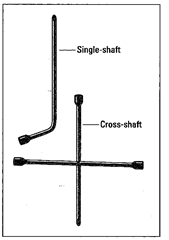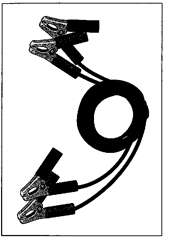You can pack your toolbox with the best tools that money can buy, but all those fancy gadgets and gizmos won’t do you any good if they’re in your garage at home when your car breaks down 30 miles from civilization. Don’t tempt fate: Keep these tools and materials onboard at all times (you probably have most of this stuff already, so there’s no excuse for being unprepared):
Rags:
Rags should be clean and lint-free.
Get rid of gasoline-soaked rags — they’re highly combustible. Never keep them in closed places. Don’t use an oily rag on anything that isn’t oily already. Because your car contains a variety of substances that must be kept away from other substances, throw out or wash dirty rags, and use a clean one each time you start a job. Keep a clean, lint-free rag in your glove compartment; you’ll need it to wipe your oil or transmission dipstick.
Spare parts:
If you replace your spark plugs and your points, save the old ones if they’re not too worn. Carry them in your trunk compartment toolbox for quick replacements if something goes wrong with those in your engine. Just be sure to replace these substitutes with new ones immediately, because they won’t hold up well. The same goes for old, not-too-cruddy air filters, rotors, and other minor gizmos. A couple of extra nuts, bolts, and screws also help, in case you lose the ones you have or strip them accidentally.
Emergency parts:
Buy extra accessory belts, extra coolant hoses, an extra thermostat, an extra radiator cap, and extra fuses — they’re inexpensive and could get you out of a lot of trouble on a long trip.
Spare tire:
Check your spare tire often. It’s humiliating to go through the work of changing a tire only to find that your spare is flat, too. If your spare is worn beyond belief, most garages will sell you a not-too-hidebus secondhand tire at a low price. Make sure that it’s the right size.
Lug wrench:
A lug wrench is sometimes provided, along with a jack, on new cars (see Figure 2-20). You use it to remove the wheel or lug nuts when you change your tires. If you buy a lug wrench, get the cross-shaft kind, which gives you more leverage.
Jumper cables:
One of the most common automotive malfunctions is the loss of power to start it, either from an old or faulty battery or from leaving the headlights on by mistake. If you’re in this situation, you can either wait for the AAA or a nearby garage to come and bail you out, or, if you’re in a safe, well-populated area, you can stop a passing car, whip out your jumper cables (shown in Figure 2-21), attach them in seconds, and “jump a start” from the Good Samaritan’s car to your own. Most people are willing to lend their cars to this sort of operation because they lose nothing but a few minutes of their time, but it’s up to you to decide whether you want to risk getting car-jacked if the Good Samaritan turns out to be a devil in disguise. Chapter 21 has instructions for the proper way to jump a start.
You can buy a set of jumper cables for much less than you’d have to pay a garage to send someone to start your car. Good cables cost more because they have more strands of better-conducting wire, which let more “juice” flow between the vehicles with less loss of voltage.

Figure 2-20:
Lug wrenches are essential when you need to change a tire.

Figure 2-21:
You use jumper cables to jump-start a car.
Sometimes the success or failure of an attempt to jump a start depends on the quality of the jumper cables and their grips. If you get a cheap set, here’s an easy way to make them work better: Go under the plastic sheath that covers the place where the cables meet the grips and squeeze the connection tight with a pair of pliers. Doing so improves the connection, and sometimes the cheap set of cables works beautifully — at least for the first few times. The best way to stay out of trouble is to pay a little extra for a quality set of cables.
Snow and ice equipment:
If you live in an area that’s cold in winter, try to carry tire chains or a bag of sand in case you find yourself dealing with icy conditions. (Rock salt is no longer used for this purpose because it corrodes metal and is considered an environmental hazard.) A small shovel may prove useful for digging your tires out, and a scraper can clear your windshield if you’ve been parked in the snow and it’s iced over. A can of de-icing fluid is useful in icy weather.
Flashlights and reflectors
A flashlight is always a good addition to your glove compartment. It can help your kids locate dropped toys on the floor of the car, enable you to see under the hood if your car breaks down, and serve as an emergency light for oncoming traffic if you have to stop on the road for repairs. A flashlight with a red blinker is safest for this purpose. Of course, you have to be sure to put in fresh batteries now and then or to carry a couple of extras.
An inexpensive set of reflector triangles can save your life by making your stopped vehicle visible on the road. You can use flares, but they can be dangerous, and many states have rules regarding their use on highways.
First-aid kit:
It’s a good idea to keep a first-aid kit in your workshop and in your vehicle. Choose one that’s equipped with a variety of bandages, tweezers, surgical tape, antibiotic ointment, something soothing for burns, and a good antiseptic. You can
find one of these kits for very little money at a drugstore or an auto parts store.
Hand cleaner:
Most hand cleaners are basically grease solvents. They range from heavy-duty stuff that removes the skin along with the grease, to soothing, good-smelling creams that leave your skin feeling reborn, to precleaners that you put on your hands before you start working so that the grease slides off easily afterward. Some of these cleaners can also be rubbed into work clothes to remove grease and oil stains before you launder them.
Gloves:
Keep a pair of gloves in the car for emergencies. Thin, tough, and comfortable dishwashing gloves are available at any discount store or supermarket. They cost little and keep the grease from under your fingernails. One problem, however, is that gasoline or solvent may melt them. If you prefer, industrial rubber gloves, available at swimming pool supply stores, aren’t affected by gasoline, solvent, or battery acid.
Spare tools:
If you can’t carry your toolbox in your car all the time, try to leave a couple of screwdrivers, some standard-size combination wrenches, an adjustable wrench, and a can of penetrating oil in your trunk compartment. Some very handy gizmos that combine a variety of basic tools into one all-purpose, weird-looking instrument are also available.
Hat:
To keep the dust and grease out of your hair, and to prevent long hair from being caught in moving parts, wear a hat that you can afford to get dirty. A wooly watch cap or a baseball hat worn backwards works just fine.
Cellular phone:
This device is useful when you’re stuck on a road somewhere with a dead car or when you have an accident. You can call your loved ones or friends for help or call the auto club (some cell phones have an AAA or 911 call button) or the police.
Miscellaneous stuff:
A roll of duct tape, a roll of electrician’s tape, a sharp knife, and scissors also come in handy.
